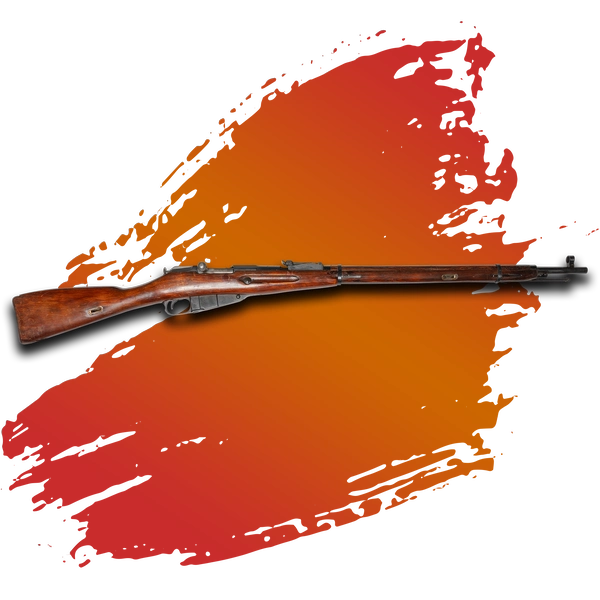Mosin Nagant custom

3 lövés
Az M1891 háromvonalas puska (oroszul: трёхлинейная винтовка образца 1891 года, tryokhlineynaya vintovka obraztsa 1891 goda) a nyugati köznyelvben Mosin–Nagantként, Oroszországban pedig Mosin puskájaként (oroszul: винтовка Мосина, ISO 9: vintovka Mosina) ismert, egy 5-lövéses, forgó-tolózáras, belső tárból töltött katonai puska, amelyet 1882 és 1891 között fejlesztettek ki, és az orosz cári hadsereg, a Szovjetunió, illetve számos más ország hadserege is alkalmazta. Ez a történelem egyik legnagyobb számban gyártott katonai forgó-tolózáras puskája, több mint 37 millió példányban készült az 1891-es bemutatása óta, és kora ellenére számos konfliktusban használták világszerte még a modern időkben is. Főként az eredeti 7.62×54mmR lőszerhez készült.
Az 1877-1878-as orosz-török háború alatt a főként a Berdan egylövetű puskákkal felszerelt orosz csapatok súlyos veszteséget szenvedtek a török hadsereggel szemben, akik Winchester ismétlőpuskával voltak felszerelve, főleg Plevna véres ostrománál. Ez rávilágított az orosz parancsnokok számára arra, hogy szükség van a hadsereg szabványos gyalogsági fegyverzetének modernizálására. Számos fegyvert szerzett be és tesztelt az Orosz Birodalom hadügyminisztériumának Fő Tüzérségi Igazgatósága (GAU), és 1889-ben megszerezték a Lebel M1886 modellt félhivatalos csatornákon keresztül Franciaországból. Tölténnyel és lövedékkel együtt szállították le, viszont gyutacs és füstnélküli lőpor nélkül. Ezeket a problémákat az orosz tudósok és mérnökök megoldották (a füstnélküli lőport például maga Dmitrij Mengyelejev fejlesztette ki).
1889-ben három puskát nyújtottak be értékelésre: a birodalmi hadsereg kapitánya, Szergej Ivanovics Mosin bemutatta “háromvonalas” kaliberű (.30 kaliber, 7.62 mm) puskáját; Léon Nagant belga tervező bemutatott egy “3,5 vonalas” (.35 kaliber, 9 mm) dizájnt; Zinovjev kapitány pedig egy további “háromvonalas” konstrukciót (1 "vonal" = 1⁄10 hüvelyk vagy 2.54 mm, így 3 vonal = 7.62mm) mutatott be.
A próbák befejeztével 1891-ben az értékelőbizottság véleménye megoszlott. A Nagant-puska főbb hátrányai közé tartozott a sokkal bonyolultabb mechanizmusa, és a szétszerelés hosszadalmas és fárasztó procedúrája (speciális szerszámokat igényelt — ki kellett csavarni két rögzítőcsavart). Mosin puskáját leginkább a gyengébb gyártási minősége és anyaga miatt kritizálták, mivel a 300 darabos sorozata még “kézi előgyártásban” készült. A bizottság kezdetben 14:10 arányban szavazott a Nagant-puska jóváhagyása mellett. Ekkor született döntés arról, hogy megváltoztatják a jelenlegi bizottság nevét Kis Kaliberű Puska Készítésének Bizottságára (Комиссия для выработки образца малокалиберного ружья), és papírra vetik egy ilyen puskának a végleges követelményeit. A feltalálók eleget tettek a kérésnek végleges terveik benyújtásával. A bizottság vezetője, Csagin tábornok elrendelte további tesztek elvégzését a bizottság felügyelete alatt, ami után gyártásba rendelték Mosin dizájnának forgó-tolózáras mechanizmusát háromvonalas M1891-es puska (трёхлинейная винтовка образца 1891 года) néven.
A Gewehr 98-hoz hasonlóan az 1891-es Mosin két elülső reteszelőfület használ az akció zárásához. Mosin esetében viszont a fülek vízszintes pozícióban zárnak, míg a Mauser függőleges irányban záródik. A Mosin zárteste több darabból áll, míg a Mauser egyből. A Mosin cserélhető zárfejeket alkalmaz, csakúgy, mint a Lee–Enfield. A Mauserrel ellentétben, amely „kontrollált töltésű” zárfejet használ, amelyben a töltényalj a rögzített kivonó alá csúszik, miközben a töltény a tárból töltődik, a Mosin „tolásos betöltésű”, süllyesztett zárfejjel rendelkezik, amelyben a rugós kivonó a töltényalj fölé pattan, miközben a zár végül bezáródik, hasonlóan a Gewehr 1888-hoz, az M91 Carcano-hoz, vagy a modern sport puskákhoz, mint például a Remington 700. A Mauserhez hasonlóan a Mosin is tokba épített penge típusú töltényhüvely-kivetővel rendelkezik. A Mosin zára eltávolítható csupán a tok végéig való kihúzásával és az elsütőbillentyű lenyomásával, míg a Mausernek az elsütőbillentyűtől különálló zármegállító karja van.
A Mauserhez hasonlóan a Mosin-Naganton lévő záremelő ív 90 fokos, a Lee-Enfield-el ellentétben, amely 60 fokos. A Mauser zárkarja a zártest végén található, és a tömör hátsó tokgyűrű mögött reteszel. A Mosin zácmdrkarja hasonlít a Mannlicherére: egy nyúlványra van rögzítve a zártest közepén, amely zárvezetőként szolgál, és a hüvelykivető/betöltő nyílásból kiállva reteszel egy kettéválasztott hátsó tokgyűrű előtt, amely a Mauser “harmadik” vagy “biztonsági” fogantyújához hasonló funkciót lát el.
A Mosin cső huzagolása jobbra húzott (óramutató járásával megegyező irányban, a puska aljára nézve) 4 barázdás 1:9.5" vagy 1:10" csavarvonallal. Az 5 lövéses merev fémtárba vagy egyesével illesztik be a töltényt, vagy katonai szolgálatban gyakrabban az 5 lövéses töltő segítségével
Kaliber:
7,62x54R
Ár:
6120 HUF
Csomagban elérhető:
Egyéb